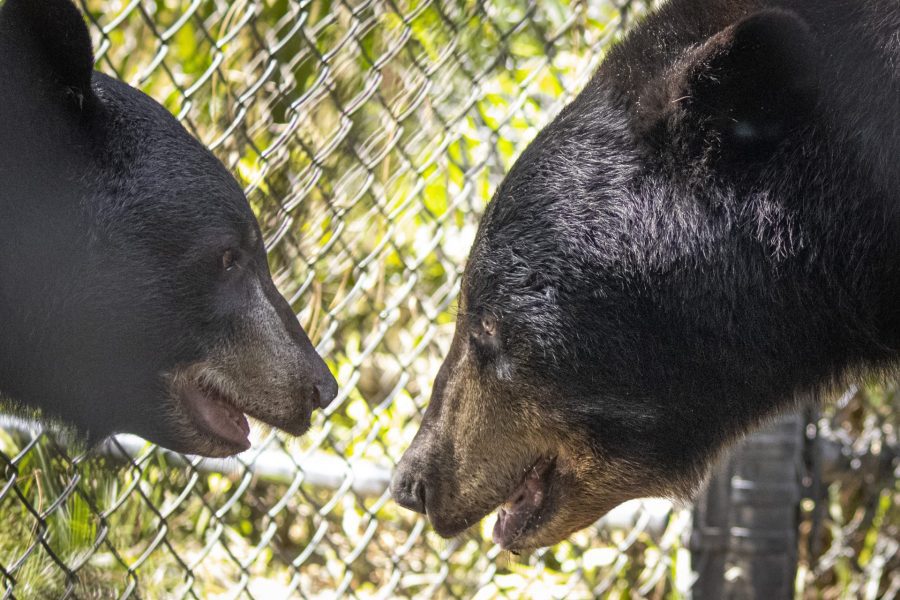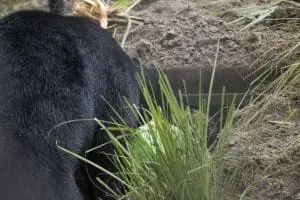

Florida black bears Brody and Cheyenne look at each other during one of their first introductions.
We’re calling this month “FebruBeary” in honor of our two Florida black bears, Brody and Cheyenne! We don’t know their exact birthdays, since they were both born in their natural range. As all black bears are born in January or February while the female is denning, we’ve estimated both of their birthdates to be around this time of year.
To celebrate Cheyenne and Brody, we wanted to take you back through our journey with these two bear-y special residents.
It’s been almost four years since your Zoo answered the call to work with Florida Fish and Wildlife Conservation Commission (FWC) to give a permanent home to Florida black bears who can’t safely live in their natural range. In that time, we’ve seen our Florida black bear habitat change as we gain more understanding of this species.
Bringing Up Bears
Cheyenne first joined our Zoo in 2018 after she became accustomed to receiving dog food from a woman in Tallahassee. Cheyenne became accustomed to interacting with humans, so FWC stepped in and removed her before a tragedy occurred.
The now nearly 5-year-old bear was noted as being very smart, curious and attentive by her keepers upon arriving at the Zoo. These descriptors have stood the test of time as we’ve watched Cheyenne interact with her enrichments and habitat.

Lauren Hinson feeds a weeks-old Brody.
About a year into caring for Cheyenne, our Zoo took on the extremely rare responsibility of raising a weeks-old Florida black bear who was eventually named Brody. No one, not even FWC, expected to be in the position of taking in a bear cub that young, said Lauren Hinson, our director of animal programs.
Lauren, who has raised a number of Zoo babies, was the primary caregiver for Brody.
“I personally did a lot of research, reading, and based a lot of my knowledge of raising other baby animals and my ability to understand behavior,” Lauren said. “Turns out bears are pretty good at communicating with people.”
As he grew, Brody needed some specialized healthcare along his journey with us, from a special surgery on his hips to stem-cell therapy. We’re happy to report that the now nearly 2-year-old is healthy and doing well.
We took our time introducing Brody and Cheyenne, with mesh fencing as a buffer between the two for some time. During their first physical introduction, the two embraced immediately and started to play.
Cheyenne is still dominant over Brody and likely to be so for a while longer. Right now, keepers note that Cheyenne doesn’t want Brody around as she defends her territory and den. This natural behavior is exactly what she would do in her natural range if she found a young male bear roaming in her space. This will change with every season.
Thankfully, our bear habitat can be a home to several bears! Brody lives comfortably in a behind-the-scenes area of the habitat.
Learning About Bears at the Zoo
A lot of research went into designing our black bear habitat, with our animal care staff looking into enrichment, diet and options for privacy for our bears, Lauren said.
As we’ve seen our bears interact with their habitat, we’ve evolved their space to be more conducive to their natural behaviors like making the habitat’s trees more accessible for climbing and perching.

Florida black bear Brody peeks inside one of the new bear dens.
Taking note that Cheyenne was interested in building a den during the winter months, we went on to build a den in the bear’s public habitat as well as their private space. This season, Cheyenne has been using one of the dens (which can be seen on a live feed at the Zoo) fairly regularly.
Speaking of seasons, we adjust our bears’ enrichment opportunities according to the time of year. Enrichment can be anything that encourages an animal resident’s natural behaviors. For our black bears, this often means giving them the option to forage for their food in a variety of ways, from shaking it out of a wobble tree to digging it out of a special feeder ball.
In the fall, we’ve noticed that Brody and Cheyenne are motivated but want easy food to bulk up for winter – so enrichments are less complex. During the winter, the bears are more sluggish and uninterested in food, while in the spring they have more energy and motivation to work through more complex enrichments.
“Even though Brody and Cheyenne have spent most or all of their lives in human care, they still will carry out natural bear behaviors if we give them the necessary resources and it can be extremely enriching and rewarding,” Lauren said.
Living with Bears
Thanks to conservation efforts, the Florida black bear population has gone from just a few hundred bears in the 1970s to an estimated 4,000-plus bears today. However, as the populations of people and bears grow and bear habitat decreases in Florida we’re seeing this species getting into more conflicts with people.
One of the best ways to avoid interactions with black bears is to secure or remove anything that would be attractive to them – mainly food. One major change: Use bear-resistant trashcans (or modify your existing trashcan) and put out your trashcan the night before pickup. For more tips, visit the FWC website.
We can live safely and comfortably with Florida black bears like Cheyenne and Brody if we can make changes to keep both of our species safe. While you celebrate FebruBeary with us, we ask that you consider how to make your home or surroundings less attractive to Florida black bears.
Brevard Zoo is an independent, not-for-profit organization that receives no recurring government funding for our operating costs. Your generous support enables us to continue to serve our community and continue our vital animal wellness, education and conservation programs.
